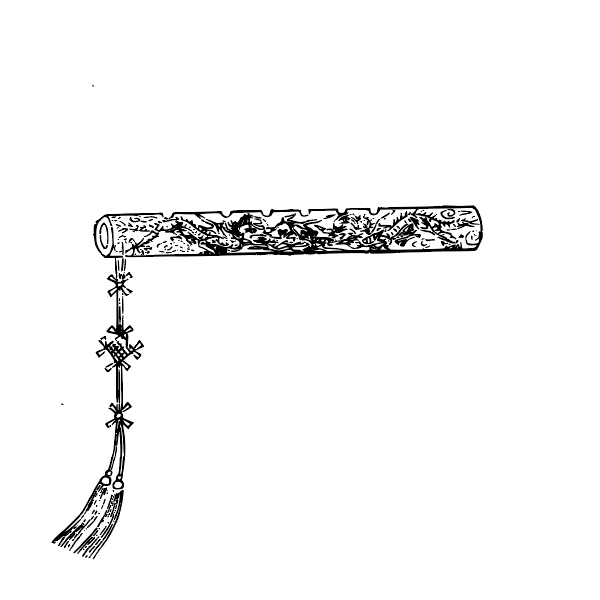chi overview
 Chi (pinyin: Chí) is a musical instrument that blows and sings. An ancient Chinese horizontal blowing bamboo wind instrument. "Guang Ya" records that this instrument has eight holes, but "Zhou Li" records that this instrument has seven holes, and with the gradual decline of court music, this kind of Chinese musical instrument is very rare. The obvious difference between a chi and a flute is that the bottom end of the chi is completely closed with bamboo joints, while the bottom end of the flute is open.
Chi (pinyin: Chí) is a musical instrument that blows and sings. An ancient Chinese horizontal blowing bamboo wind instrument. "Guang Ya" records that this instrument has eight holes, but "Zhou Li" records that this instrument has seven holes, and with the gradual decline of court music, this kind of Chinese musical instrument is very rare. The obvious difference between a chi and a flute is that the bottom end of the chi is completely closed with bamboo joints, while the bottom end of the flute is open.According to the records of "Zhou Li·Zhengxuan Notes" and Chen Yang's "Book of Music", they all say that the chi is a kind of horizontal blowing bamboo wind instrument with 6 holes (including the upper exit hole) and the bottom end is closed. Judging from the two horizontal-blown bamboo wind instruments unearthed from the tomb of Marquis Yi of Zeng at the beginning of the Warring States Period, they are both similar in characteristics to the chi described in the literature, but different from the flute. Therefore, at the latest in the Han Dynasty, the chi and the flute should be the same musical instruments with similar pronunciation but different shapes.
In the circulation of the chi, its shape has also changed slightly. According to Guo Pu, a Jin person, in the "Erya·Shile", as late as the Jin Dynasty, its blow hole had been changed to a 1 inch and 3 minutes higher than the pipe body (approximately 3 minutes). 4.3 cm) of the "Qiao" (the so-called "yizui" later) played. Other forms have not changed. According to literature records, almost all of the Chi used in the Song and Ming courts were of this type.
Chi Yuan is a Chinese folk musical instrument. As early as the Zhou Dynasty, it was often played together with Xun. During the Warring States Period, as a member of a large-scale court band, it played with chimes, chimes, drums, xiao (panpipes), sheng and se, etc. when worshipping gods or feasting. It is also used by the Xianghe Song Band of the Han and Wei Dynasties. In the Six Dynasties, with the rise of Qing Shang music, it became the main accompaniment instrument of Wu Sheng. During the Sui and Tang Dynasties, it was a member of the most artistic Qingle band at that time. After the Song Dynasty, it was gradually lost because it was mainly used for court music.
The way of playing Chi is based on the wooden figurines made in the Yangjiawan Han Tomb in Changsha and the portraits of Yuanhe and Zhanghejian (83-87 AD) in Wuyang, South Shandong. ﹑ Between the index fingers, the blow hole and the sound hole are upward at 180°, the left hand index, middle, and ring fingers press holes 1, 2, and 3 respectively, and the middle and index fingers of the right hand press holes 4, 5.
The performance of the chi can be seen from the sound measurement results of the chi copied from the tomb of Zeng Houyi. The simplest fingering method can produce 6 tones, that is, a complete pentatonic scale plus a changed tone. According to literature records, the Chi in Song and Ming Dynasties could use the half-hole fingering method to blow all twelve laws. Whether the Chi before the Song Dynasty used the half-hole fingering is still difficult to determine because there is no conclusive proof.
- Pinyin:chí
- Classification:Horizontal bamboo wind instrument
- source:China
overview of other similar instruments
- sanyanxiao overview
- Daguangxian overview
- Leiqin overview
- hahao overview
- yandundagu overview
- Han Xiaozheng overview
- Fang Xiang overview
- guanzi overview
- zhuqin (Dao Qin) overview
- zhuiqin overview
- bangzi overview
- three-stringed piano overview
- Gehu overview
- xiao overview
- xiaokonghou overview
- Konghou overview
- Sheng overview
- suona overview
- hulusi overview
- gushao overview
 渝公网安备 50010702504639号
渝公网安备 50010702504639号